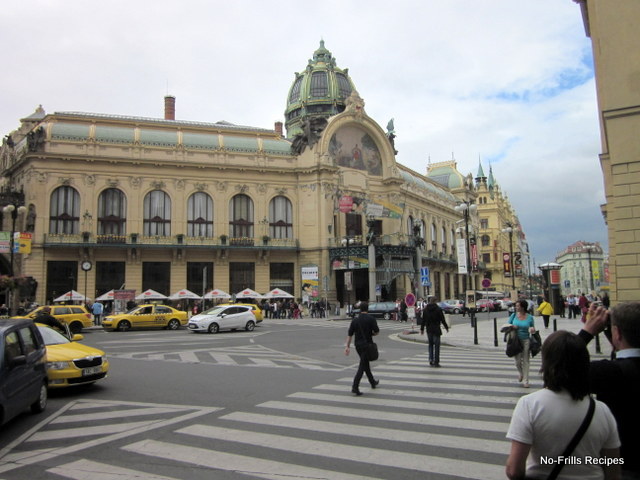This free of traffic Prague's Old Town Square is among the finest public places in the city. You can only see horse drawn carriages and some police patrol cars parked in this area. The picture above, with the brown roof is the Kinsky Palace which now serves as an art gallery.
Church of Our Lady before Tyn ~ the church's Gothic (spires soar skywards) steeples are the Old Town's most distinctive landmark.
The Storch house (centre) has painted decoration based on designs by Mikulas Ales showing St. Wenceslas on horseback.
The Powder Gate ~ this gate is one of the 13 entrances to the Old Town. This gate had little defensive value only its rich sculptural decoration which was intended to add prestige to the adjacent palace of the Royal Court. It acquired its present name when it was used to store gunpowder in the 17th Century.
The above two pictures used to be the former Royal Court Palace, the King's residence between 1383 and 1485 but now it's been turned into a Municipal House with cafes and restaurants on the ground floor.
Church of St. Nicholas ~ The dome has frescoes (wall painting) of the lives of St. Nicholas and St. Benedict. In the nave is a huge crown-shaped chandelier. In World War I the church was used by the troops of Prague's garrison. At the end of the war, the church of St. Nicholas was given to the Czechoslovak Hussite Church. The church is now a popular concert venue.
Charles Street ~ a house decorated with the Art Nouveau statue of the legendary Princess Libuse surrounded by roses.
Old Town Bridge Tower ~ a magnificent Gothic tower built at the end of the 14th Century on Charles Bridge, one of the oldest stone bridges in Europe. Charles Bridge is famous for the many statues of saints that adorned the entire length of the bridge. For centuries, this bridge was the only link between the Lesser Town on the left bank of the Vltava river and Old Town on the opposite side.
Statue of Madonna and St. Bernard, 1709
The statue of St. John of Nepomuk. On 20 March 1393 he was thrown into the river Vltava from the Charles Bridge at the command of Wenceslas, King of the Romans and King of Bohemia.
17th Century Crucifixation ~ for 200 years the wooden crucifix stood alone on the bridge. The gilded Christ dates from 1629 and the Hebrew words 'Holy, Holy, Holy Lord', were paid for by a Jew as a punishment for blasphemy.
Boat trip excursions along the Vltava river passing below Charles Bridge.
Hope you've enjoyed your trip to Prague, thus far!
















0 komentar:
Posting Komentar